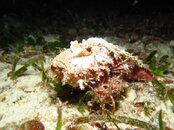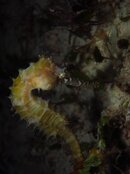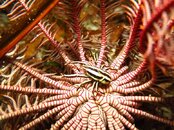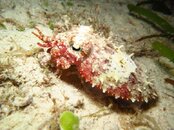Hi All,
I just got back from a dive trip last month and faced some difficulties trying out underwater photography for the first time.
My set up:
S100 in Recsea housing + 1 S&S YS-01 Strobe.
I shoot mostly in manual mode, ISO 80 and manually adjust my strobe's output.
My camera's settings as such
Digital zoom: off
Servo AF: on
AF-assist beam: off
MF-point zoom: on
Safety MF: on
Spot AE point: AF point
With those settings, I've had pics either over exposed, or under exposed. (what should I adjust here? my strobe output or camera settings?)
My strobe is placed above my housing, pointing slightly down.
All photos were taken at night.


Also, I found it very difficult to focus underwater (i used macro mode to help focus but with the small screen, i cant really tell if my subject is focused until i see it on the computer.)

I just bought a SOLA 800, and intending to fixed it onto the recsea housing to help with focusing at night. Will the focus light cause my photos to be overexposed?
I found myself constantly adjusting my camera's settings and also the strobe's output. Is there a way to streamline this so that I dont have to adjust so many factors underwater and just concentrate on framing the subject?

I'm not sure if my settings are suitable underwater photography so I would appreciate some advise here.
Thanks everyone.
I just got back from a dive trip last month and faced some difficulties trying out underwater photography for the first time.
My set up:
S100 in Recsea housing + 1 S&S YS-01 Strobe.
I shoot mostly in manual mode, ISO 80 and manually adjust my strobe's output.
My camera's settings as such
Digital zoom: off
Servo AF: on
AF-assist beam: off
MF-point zoom: on
Safety MF: on
Spot AE point: AF point
With those settings, I've had pics either over exposed, or under exposed. (what should I adjust here? my strobe output or camera settings?)
My strobe is placed above my housing, pointing slightly down.
All photos were taken at night.


Also, I found it very difficult to focus underwater (i used macro mode to help focus but with the small screen, i cant really tell if my subject is focused until i see it on the computer.)

I just bought a SOLA 800, and intending to fixed it onto the recsea housing to help with focusing at night. Will the focus light cause my photos to be overexposed?
I found myself constantly adjusting my camera's settings and also the strobe's output. Is there a way to streamline this so that I dont have to adjust so many factors underwater and just concentrate on framing the subject?

I'm not sure if my settings are suitable underwater photography so I would appreciate some advise here.
Thanks everyone.



